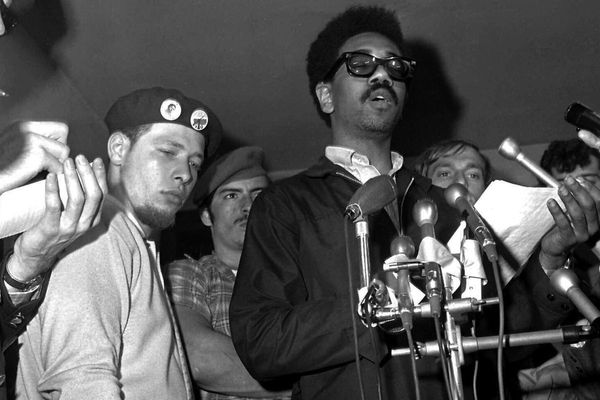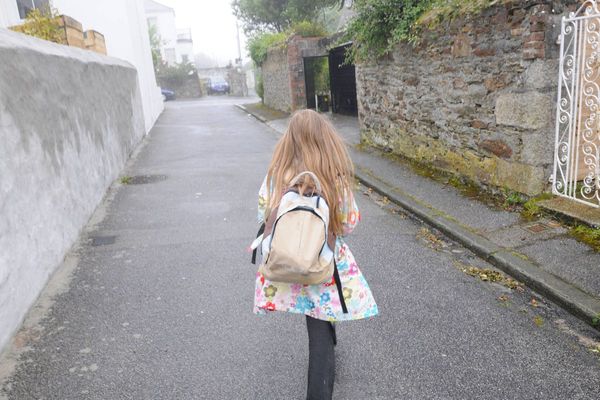
The crowd was still getting seated inside a big red circus tent near Saitama Stadium when a red-nosed clown appeared in their midst.
In a gold hat, purple shirt, Chaplinesque trousers and Brobdingnagian shoes, Aaron Tucker bestowed exuberant greetings as he moved through the stands, shaking hands, sitting down next to people, kissing an old lady on the hand and admiring a child's stuffed animal. At one point, Tucker and an audience member delightedly took turns mopping each other's bald heads with an oversized handkerchief.
Another clown, who performs under the name Jessi Wonderfool, socialized with spectators in a different part of the stands, decked out in a blue wig, puffy skirt and striped stockings.

"We try to go out there and meet everybody that we can," Tucker, 51, said in an interview after a recent Kinoshita Circus performance. "We're there to say hello, we're like the concierge or the maitre d', there to welcome you in ... It's one of my favorite things to do."
The Kinoshita Circus includes lions, elephants, jugglers, dancers, magic and aerial acts, but the clowns make the first impression.
Tucker, who was born in St. Louis, Mo., and grew up in Baltimore, Md., remembered the first impression legendary American clown Lou Jacobs (1903-1992) made on him when Tucker was 5 years old.

"My parents took me to the circus, and I saw the clowns [including Jacobs]. I loved them immediately. But the big thing was, after they were finished, they went through the back curtain, and I saw just a little sliver -- somebody pushing a unicycle, and the leg of an elephant. I said: 'I wanna go back there. I wanna see what's going on' … My whole life was about getting behind the curtain."
Jacobs performed with the Ringling Bros. and Barnum & Bailey Circus, which ended its 146-year history when it shut down in 2017. He was also a teacher at the circus' Clown College. Tucker became one of his students in 1988, before a stint as a Ringling clown himself.
"When I was in Clown College, we played with makeup every day," he said. "The makeup is about trying to get the back row of the audience to be able to see what my face is doing. So all the shapes that are on my face are just to exaggerate what my normal face does."
He also learned "how to make big, clean gestures. We talked a lot about making everything like a cartoon." The clowns closely studied characters like Bugs Bunny and Daffy Duck because the old-fashioned animation included "no extra movement ... Everything is purposeful."
Tucker also built up his performing chops in such contexts as an Austin, Texas, rock band and what he describes as "movement theater," in which he moved to improvised music in a manner inspired by Japanese dancer Min Tanaka.
Tucker came to Japan himself 12 years ago, after hearing about the Kinoshita Circus from a fellow clown. Established in 1902, the Okayama-based traveling show bills itself as the oldest and largest circus in Japan. It continued performing even during World War II and now plays to audiences of about 1.2 million people a year, according to the circus.
"Hiroshima ... was the first big city that we played, when I got here. Everyone was immediately friendly to me there, and the city is beautiful and fascinating. It kind of reminds me of a cross between San Francisco and New Orleans," Tucker recalled.
"I also love the Bon Odori dancing. I love to see a community dancing together. There's something really lovely about that," Tucker said.
Asked about audiences in Japan, he said: "My impression is that Japanese people like cleverness. When I see a manzai performance I know that the jokes comment on themselves, they're multilevel, they're very smart. The kind of humor that we do is really dumb. It's really stupid, and it's simple. I think that Japanese people, there's a way that we have to let them know that it's OK to laugh at us ... When it's clear that we mean to be dumb, then it works really well."
In one gag, for instance, Tucker asks for Jessi's help in getting an object down from a high place, using a ladder. Once she has climbed up to where the object is, he takes the ladder and strolls away, blithely unaware that he has literally left her hanging.
In another gag, Tucker shows off his karate prowess by using his bare hand to "break" a wooden board that is quite obviously already broken. When Jessi presents him with a second board -- unbroken -- something surprising and absurd happens.
Healing with laughter
Tucker said he performed with the Kinoshita Circus for about 3-1/2 years, and then spent three years doing "clown care" at Boston Children's Hospital and Hasbro Children's Hospital in Providence, R.I., before returning to Japan and Kinoshita almost six years ago. In total, he has spent nine of the past 12 years in Japan.
He described clown care as "intense, but it's really all about the child in the room and the family with the kid. The mandate we had was to change the energy in the room. We would do rounds like doctors ... Sometimes it's just a quick visit to say, 'How ya doing?' and sometimes you need to start throwing toilet paper around the room ... You don't know what it is until you get there."
Perceiving what is right for that tiny audience is a skill that transfers to the big top, especially when it comes to choosing volunteers to participate in certain gags.
"You can see it in their eyes. When they're ready to play, you can see that they want to," Tucker said. "I want them to be people that will enjoy it … I want them to come off the floor and say that they had a good time, their day to be better because they've had a good experience with me."
The greetings at the beginning of the show surely help prepare people for that good experience, and the clowns build familiarity by appearing repeatedly between other acts. Tucker said they try to break down "whatever is us-and-them about the show ... and it becomes, 'We're all the circus.' This is something that we did together. We needed the audience to make this happen."
-- Quick Questions
Q: What was your first impression of Japan?
A: "Chaotic. Everything was very fast. Fast and dark, because I got here in the evening ... Mysterious. That's a much better word."
Q: What is your favorite Japanese word?
A: "Ongaku. Music. I just like the way that sounds."
Q: Who is one of your role models?
A: "Louis Armstrong. When I think of him, I think about someone who is about reflecting love to the world, and that's my best self."
Q: What's your shoe size?
A: "My actual shoe size in Japan is a 32, and my clown shoe size … [Lifts a gigantic foot] This might be a 45, maybe?"
Read more from The Japan News at https://japannews.yomiuri.co.jp/







